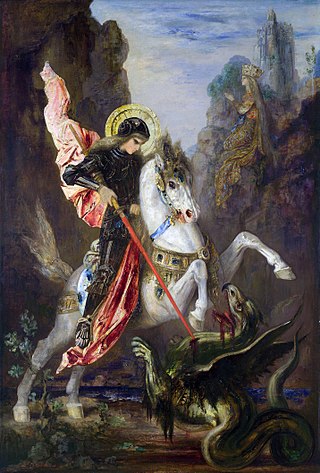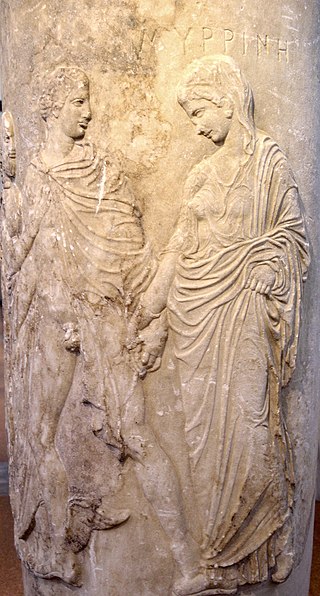Related Research Articles

Christian mythology is the body of myths associated with Christianity. The term encompasses a broad variety of legends and narratives, especially those considered sacred narratives. Mythological themes and elements occur throughout Christian literature, including recurring myths such as ascending a mountain, the axis mundi, myths of combat, descent into the Underworld, accounts of a dying-and-rising god, a flood myth, stories about the founding of a tribe or city, and myths about great heroes of the past, paradises, and self-sacrifice.

Psychopomps are creatures, spirits, angels, demons or deities in many religions whose responsibility is to escort newly deceased souls from Earth to the afterlife.

In Aztec mythology, Xolotl was a god of fire and lightning. He was commonly depicted as a dog-headed man and was a soul-guide for the dead. He was also god of twins, monsters, misfortune, sickness, and deformities. Xolotl is the canine brother and twin of Quetzalcoatl, the pair being sons of the virgin Chimalma. He is the dark personification of Venus, the evening star, and was associated with heavenly fire. The axolotl is named after him.

Mythology of the Haudenosaunee includes the creation stories and folktales of the Native Americans who formed the confederacy of the Five Nations, later the Six Nations (Iroquois). Historically, these stories were recorded in wampum and recited, only being written down later. In the written versions, the spellings of names differ due to transliteration and spelling variations in European languages that were not yet standardized. Variants of the stories exist, reflecting different localities and times.

Chinese mythology is mythology that has been passed down in oral form or recorded in literature throughout the area now known as Greater China. Chinese mythology includes many varied myths from regional and cultural traditions. Much of the mythology involves exciting stories full of fantastic people and beings, the use of magical powers, often taking place in an exotic mythological place or time. Like many mythologies, Chinese mythology has in the past been believed to be, at least in part, a factual recording of history. Along with Chinese folklore, Chinese mythology forms an important part of Chinese folk religion and Taoism, especially older popular forms of it. Many stories regarding characters and events of the distant past have a double tradition: ones which present a more historicized or euhemerized version and ones which present a more mythological version.

The Indigenous peoples of the Americas comprise numerous different cultures. Each has its own mythologies, many of which share certain themes across cultural boundaries. In North American mythologies, common themes include a close relation to nature and animals as well as belief in a Great Spirit that is conceived of in various ways.
The Genesis creation narrative is the creation myth of both Judaism and Christianity. The narrative is made up of two stories, roughly equivalent to the first two chapters of the Book of Genesis. In the first, Elohim creates the heavens and the Earth in six days, then rests on, blesses, and sanctifies the seventh. In the second story God creates Adam, the first man, from dust and places him in the Garden of Eden. There he is given dominion over the animals. Eve, the first woman, is created from Adam's rib as his companion.

Animal worship is an umbrella term designating religious or ritual practices involving animals. This includes the worship of animal deities or animal sacrifice. An animal 'cult' is formed when a species is taken to represent a religious figure. Animal cults can be classified according to their formal features or by their symbolic content.

Mother Nature is a personification of nature that focuses on the life-giving and nurturing aspects of nature by embodying it, in the form of the mother.
The Fifth World in the context of creation myths describes the present world as interpreted by several indigenous groups in the USA and Mexico. The central theme of the myth holds that there were four other cycles of creation and destruction that preceded the Fifth World. The creation story is taken largely from the mythological, cosmological, and eschatological beliefs and traditions of earlier Mesoamerican cultures.
The Lozi people believed in a creator god, whom the Lozi call Nyambe. Nyambe's wife was Nasilele and his mother was Ngula. Nyambe is said to have created both his wife and his mother. He is also said to have created everything else that exists, including the heaven, the Earth and all the plants and animals.

Asase Ya/Afua is the Akan goddess of fertility, love, procreation, peace, truth and the dry and lush earth in Ghana and Ivory Coast. She is also Mother of the Dead known as Mother Earth or Aberewaa.

Akan religion comprises the traditional beliefs and religious practices of the Akan people of Ghana and eastern Ivory Coast. Akan religion is referred to as Akom. Although most Akan people have identified as Christians since the early 20th century, Akan religion remains practiced by some and is often syncretized with Christianity. The Akan have many subgroups, so the religion varies greatly by region and subgroup. Similar to other traditional religions of West and Central Africa such as West African Vodun, Yoruba religion, or Odinani, Akan cosmology consists of a senior god who generally does not interact with humans and many gods who assist humans.
Mbombo, also called Bumba, is the creator god in the religion and mythology of the Kuba people of Central Africa in the area that is now known as Democratic Republic of the Congo. In the Mbombo creation myth, Mbombo was a giant in form and white in color. The myth describes the creation of the universe from nothing.

Bantu religion is the system of beliefs and legends of the Bantu people of Africa. Although Bantu peoples account for several hundred different ethnic groups, there is a high degree of homogeneity in Bantu cultures and customs, just as in Bantu languages. Many Bantu cultures traditionally believed in a supreme god whose name is a variation of Nyambe/Nzambe.

Vattisen Yaly is a contemporary revival of the ethnic religion of the Chuvash people, a Turkic ethnicity of Bulgar ancestry mostly settled in the republic of Chuvashia and surrounding federal subjects of Russia.
The Serer creation myth is the traditional creation myth of the Serer people of Senegal, the Gambia and Mauritania. Many Serers who adhere to the tenets of the Serer religion believe these narratives to be sacred. Some aspects of Serer religious and Ndut traditions are included in the narratives contained herein but are not limited to them.
Woyengi is the creator goddess of the Ijo people of Nigeria. She is also known as the goddess of fate in certain depictions.
Wulbari is a supreme deity figure worshipped in the traditional religions of the Krache and Guang people in Ghana and Togo. Aside from his role as a supreme deity, Wulbari is a sky god, where he lived ever since he retreated from Earth. He is also often depicted as the foil to the spider god Anansi.
References
- 1 2 3 4 Lynch, Patricia Ann; Roberts, Jeremy (2010). African Mythology, A to Z. Infobase Publishing. ISBN 978-1-4381-3133-7.
- 1 2 Thomas, Douglas; Alanamu, Temilola (2018-12-01). African Religions: Beliefs and Practices through History. ABC-CLIO. ISBN 978-1-61069-752-1.
- 1 2 3 "Kalumba Forges the Sun". Oxford Reference. Retrieved 2021-02-15.